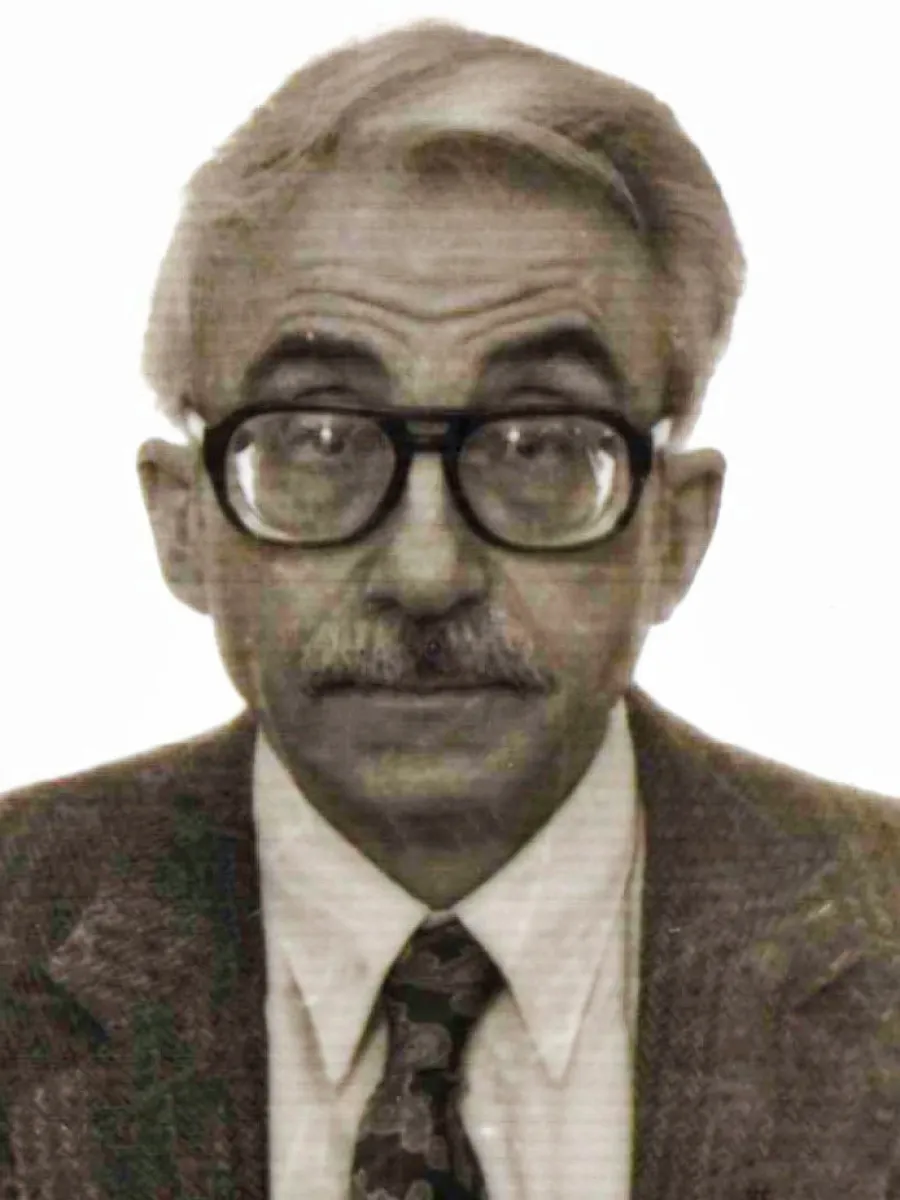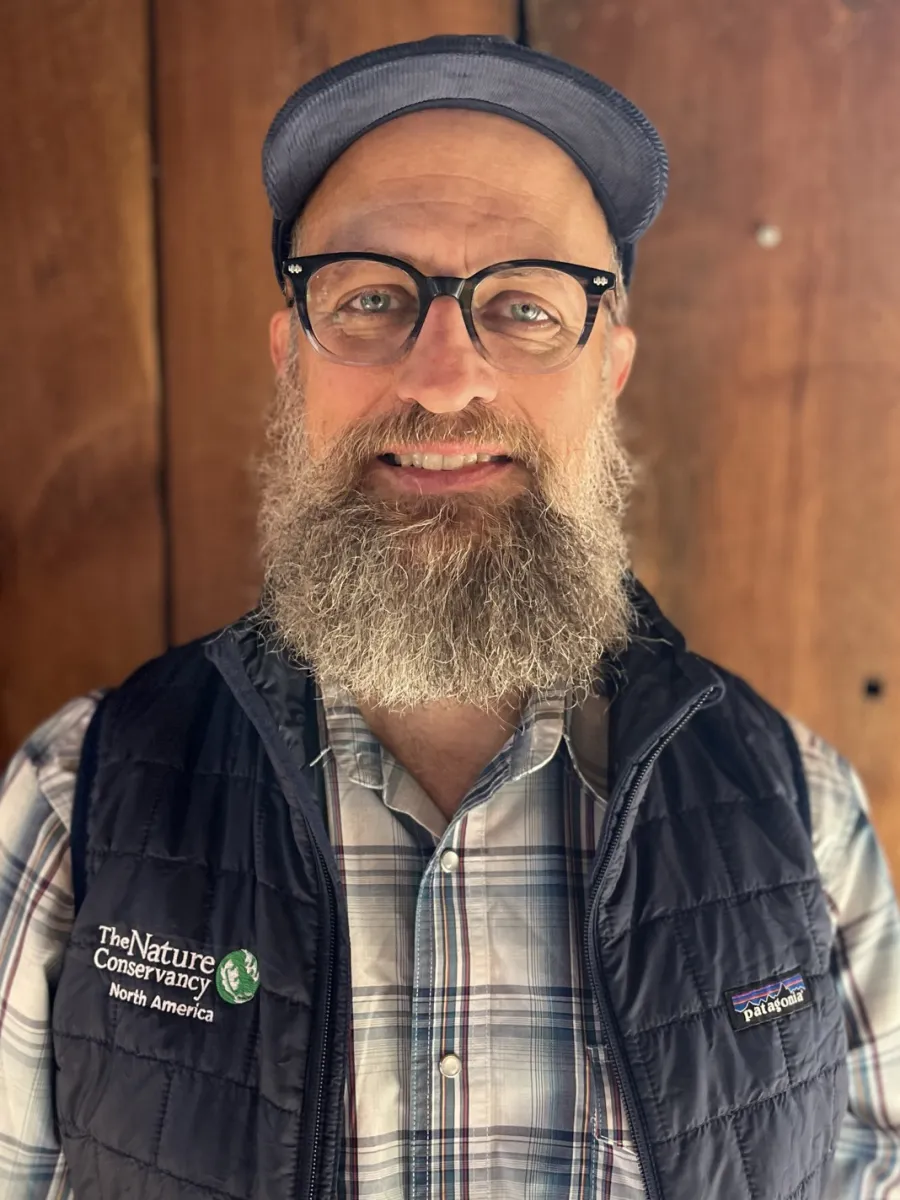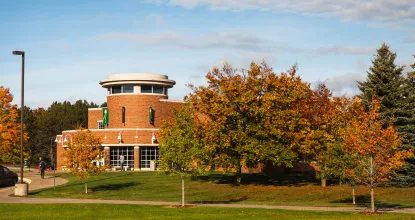The Fillmore C.F. Earney Endowment benefits EEGS students
February 1, 2023
The Fillmore C.F. Earney Endowment was established in 2003. This article traces the fund’s history and provides a few of the many examples of how scholarships from the Earney Endowment have helped EEGS students learn and grow. Private support from our loyal alumni and friends positively influences how we educate our students and respond to emerging opportunities each year. From expanding access to critical aid, such as scholarships, to developing research, gifts of all sizes matter and help our students in return help Planet Earth. We are grateful.
Dr. Fillmore C.F. Earney was a Professor of Geography at NMU from 1966 to 1996. His academic specialty was the geography of mining and mineral resources. As Professor Emeritus he is still invested in the success of the department. Dr. Frederick “Fritz” E. Nelson ’73 established the endowment in honor of his influential professor, Dr. Earney. Over the years, 22 students and counting have earned scholarships to help with their undergraduate and graduate education and prepare them for careers. Dr. Nelson, Dr. Earney, and some scholarship recipients shared these memories and sentiments with the EEGS Department.
Please visit the Fillmore C.F. Earney Endowment page for a full listing of testimonials.

Verhagen begins adjunct appointment to teach Historical Geology in W23
February 1, 2023
Christina Verhagen joined the EEGS Department this semester as a new adjunct instructor. She brings her research and presentation expertise to the GC 365 Historical Geology course that most Earth Science students take. Christina is preparing to defend her dissertation at Rutgers University in late spring. In the meantime she and her family enjoy checking out the rocks and scenery of the Upper Peninsula. We are pleased to introduce Christina.
Where are you from?
I am from Verona, New Jersey, a town in northern New Jersey about 15 miles outside of New York City.
What is your current position here at NMU and what are your responsibilities?
I am currently an adjunct instructor at NMU. I am teaching Historical Geology (GC 365) during this winter semester 2023.
What were some of your previous positions and responsibilities?
The past six years I have been working on completing my Ph.D. in Earth and Planetary Sciences from Rutgers University in New Jersey. I plan to defend my thesis this coming June. As a Ph.D. student and research scientist my main responsibilities are to conduct experiments on geological samples in the lab and analyze the data. I am responsible for data interpretation and incorporation into research papers with the goal of peer-reviewed publications. In addition to conducting my research I was in charge of the laboratory equipment and instrument maintenance and operation. I love being in the lab! It is so satisfying to start with a rock, cut it down to size to be measured on a scientific instrument, run experiments and get results that provide so much information on how, where and when that rock formed. It's like being a detective!
How would you describe your professional focus?
I am a paleomagnetist and mineralogist who mostly studies rocks from impact craters. I analyze magnetic minerals in rocks that have been altered by large meteorite impact events (like the impact event that killed the dinosaurs!). From these minerals we can learn how shock, heat and hydrothermal alteration changes the magnetic recordings within the minerals, and that in turn tells us a lot about the geological setting before, during and after an impact event.
What are your hobbies and interests?
I love all things geology, from collecting minerals and rocks to hiking to see cool outcrops. I also love music and spent a long time pursing a musical career before deciding to go back to school to finish my bachelor’s degree and pursue a graduate degree. I also love anything artistic, like painting and wood carving. Since becoming a scientist, I have found so much beauty in the rocks I analyze, and often photograph images of minerals through special microscopes. It's a new form of art to me that I really enjoy.
Is there anything else that you’d like to share?
Moving from the East Coast to Marquette has really been a wonderful change for me and my family. Marquette is a lovely community to raise a family in and the geology here is unique! On top of that Lake Superior is the cleanest water I have ever swam in. It is really magical here, even in the winter! I am happy to be part of the Earth, Environmental and Geographical Sciences Department at NMU!

Frischkorn ’18 returns to EEGS to teach a W23 course
February 1, 2023
This winter semester, Nathan Frischkorn, Esq., is teaching the Environmental Policy and Regulation course that is required in Environmental Science and for Environmental Studies and Sustainability (ENSS). Other students on campus also take the class to learn about protection of natural resources and the environment. One of Nathan’s undergraduate majors was in the EEGS Department, and it is great to have him back sharing with current students what he learned through internships and in law school. Here is a brief introduction to his background.
Where are you from?
I spent most of my childhood years near Green Bay, WI, in a little town called Suring.
What is your current position here at NMU and what are your responsibilities?
I am both an alumnus of and an Adjunct Assistant Professor in the EEGS Department. I teach GC 320 Environmental Policy and Regulation.
What is your current professional position and what is your focus?
Outside of my work with the EEGS Department, I am a staff attorney licensed by the State of Michigan. I work for a non-profit that serves the legal needs of victims and survivors of domestic violence.
What was your trajectory and what were some of your previous positions and responsibilities?
I took a very nontraditional course through college. I attended Northern right after graduating high school in 2007. I had no idea "what I wanted to be when I grew up," and ended up dropping out of college at the end of 2009. I spent some time on the West Coast, backpacking and working seasonal jobs while I tried to decide what I wanted to do long term. I came back to Northern in 2015, graduating with a double major in Environmental Studies and Sustainability, as well as Sociology. My experience in the Environmental Policy and Regulation class as a student led me to law school. After graduating from Northern in 2018, I attended the Sandra Day O'Connor College of Law at Arizona State University. During my time there, I interned with the Salt River Pima Maricopa Indian Community, the Great Lakes Environmental Law Center, and Earthjustice. However, I graduated during the COVID-19 pandemic, and nonprofit environmental law jobs were scarce. I decided that working in the public interest was more important to me than finding a corporate-side environmental law job, and took the staff attorney position that I am still working in today.
What are your hobbies and interests?
I love outdoor activities. Biking, hiking, and disc golf are some of my favorites. On the academic side, I'm passionate about water law and Federal Indian law, particularly treaty rights.
Is there anything else that you’d like to share?
I am grateful for the opportunity to teach at my alma mater, and to pass on what I have learned.

Swaty begins Research Associate position at NMU
February 1, 2023
The EEGS Department is excited to introduce Randy Swaty, our newest Research Associate, who has an office space in Weston Hall. Randy is actively engaged in mentoring students in NMU’s EEGS and Biology Departments. He shared the following information so that you can get to know him.
Where are you from?
I grew up in Little Rock, Arkansas.
What is your current position here at NMU and what are your responsibilities?
My main job is as an ecologist with The Nature Conservancy (TNC). At NMU my title is Research Associate. In that role I am the lucky recipient of office space in EEGS shared by Dr. Matt Van Grinsven, and I strive to be a good NMU community member. More specifically I am collaborating with two graduate students on their GIS directed studies, will be teaching a couple labs with Dr. Lafferty of the Biology Department and stand ready to support EEGS (and Biology) internships. As part of my TNC and NMU roles I also run the Conservation Data Lab (CDL, https://conservationdatalab.org/), a group of amazing students and young professionals who are learning technical skills, taking on conservation projects and building a super supportive community. Several CDL members are NMU students or graduates. [These will be featured on this site soon.]
What were some of your previous positions and responsibilities?
I often tell students to own all of their experiences! Maybe that is because I have been fortunate enough to have a few of my own. I have done construction work at a football stadium, worked in just about every department of a grocery store, delivered tires for a retread shop, washed dishes at multiple restaurants, tended sand traps at a golf course…the list goes on.
How would you describe your work at The Nature Conservancy?
In my work with TNC, I focus on large-scale vegetation and disturbance analyses. A great day for me is getting a call from a land manager, maybe a fire manager from a national forest, asking me to help them understand the vegetation on their landscape, past and present. I use a combination of R, ArcGIS Pro, QGIS and Microsoft tools in my work.
What are your hobbies and interests outside of work?
Outside of work I am increasingly interested in fermented foods (I just made some delicious ‘amazake’ using the Aspergillus oryzae mold. Look it up!) I love trying to fix almost anything including bikes, appliances, plumbing, etc., and I try to make wooden things. I will do just about anything outdoors.


Schoolcraft participates in NASA internship
February 1, 2023
For the past four summers, NMU students have interned at NASA as part of a partnership to study how solar radiation interacts with the atmosphere. Granite Island, near Marquette, Michigan, is an offshore site for NASA’s Clouds and the Earth’s Radiant Energy System (CERES) experiment. Equipment installed on the island monitors how solar radiation interacts with the atmosphere. Scott Holman, owner of Granite Island, facilitated the collaboration with NASA and partner Science Systems and Applications, Inc. (SSAI), with the understanding that NMU students would be involved in the research.
In Summer 2022, Environmental Science major Jayde Schoolcraft interned on a related research project at NASA Langley. In October she helped with equipment maintenance at Granite Island and met with fellow NMU students to encourage them to apply for this opportunity. Jayde shared, "I was lucky enough to spend my 2022 summer as an intern at NASA Langley Research Center. Driving up to the gates for the first time felt surreal. It felt like I didn't belong and like there was no way I was smart enough to be there. As I spent more time working and getting to know people, there was a sense of community and belonging that I could never have imagined. By the time those 10 weeks had passed, leaving the gates for the last time felt a lot like leaving home. It has now been three months since my internship ended, and I am still sad that it is over.”
Reflecting this fall on her summer opportunity, Jayde explained that, “My internship experience at NASA was perhaps the best thing that I have ever done. The opportunity has opened so many doors and I gained lifelong connections with my mentors and other interns. The skills that I learned are some that I will carry with me throughout my professional career. I also learned so much about myself and what I want to do in the future. I got to work hands-on with instrumentation and data and I loved every second of it. I will never forget the people who helped me get there and those who made it such an amazing experience."
The hope is that a fifth NMU student will gain the opportunity in 2023 to learn about science, instrumentation, data, research, and collaboration through interning at NASA and working with mentors at SSAI. Click here to learn about the origin of the NMU and NASA partnership. NMU students who are interested in applying for a NASA internship related to this project may contact eegs@nmu.edu.
Please continue reading below for Elizabeth Hoffmann's story.

Hoffmann participates in NASA internship
February 1, 2023
Elizabeth Hoffmann (BS, Earth Science, 2020) interned at NASA Langley Research Center in 2019 and remotely (because of the pandemic) in 2020. She presented her research at a regional geography conference that a group from the EEGS Department attended in Fall 2019. For her senior capstone project Elizabeth continued to analyze the radiation data. After graduating she persisted in crafting a publishable paper, with support from her mentors. Her peer-reviewed article was published in the November 2022 issue of The Geographical Bulletin.
Hoffmann shared these comments: "During my summer internship at NASA Langley Research Center in 2019, I was privileged to meet a variety of people—employees, fellow interns, local college professors—and all were enthusiastic about sharing their interests and asked me about mine. I felt welcome and included during my time at NASA Langley and couldn't stop smiling each day I drove to work. My mentors were easy to talk to, made sure I understood what my tasks were, and were available whenever I needed them. I became fast friends with the other interns I met. We discussed our different assignments and in turn inspired each other. As a first-generation college student, I never thought I would be so lucky to have an opportunity like this and be asked to return the following summer. It was truly a fantastic experience!"
The hope is that a fifth NMU student will gain the opportunity in 2023 to learn about science, instrumentation, data, research, collaboration, and communication through interning at NASA and working with mentors at SSAI. Click here to learn about the origin of the NMU and NASA partnership. NMU students who are interested in applying for a NASA internship related to this project may contact eegs@nmu.edu.

EEGS participates in East Lakes Division of American Association of Geographers Annual Meeting
February 1, 2023
The EEGS department brought 12 students to the 2022 Meeting of the East Lakes Division of the American Association of Geographers held on October 27-28. Participation in the year's conference was supported through gifts made by generous alumni and friends of the EEGS department. Muskegon Community College hosted the event, which was the first one to be held in person since Fall 2019. On the first day the group enjoyed a walking tour of downtown Muskegon. Students from Dr. Weronika Kusek’s Urban Geography class and Dr. Susy Ziegler's Human–Environment Capstone course learned about the recent redevelopment of this area along the lakeshore, with many restored historic buildings and several new entertainment venues and restaurants.
- Connor O’Loughlin, an Environmental Science student, was awarded first place in the undergraduate paper award competition for his presentation on inhibiting methane production in wetlands—research that he had conducted during an internship at Argonne National Laboratory in Summer 2022.
- Environmental Studies and Sustainability major Jane Turner presented a poster describing activities at the NMU Hoop House Community Garden.
- Students in NMU’s Eta Chi Chapter of Gamma Theta Upsilon International Geographical Honor Society met with GTU members from other schools, and the whole NMU group helped recycle e-waste through an educational service event.
Our students, faculty and staff are grateful to have the support each year from our alumni and friends. Gifts made directly to the EEGS department expand academic learning opportunities, like participation in conferences, helping more students present research findings and build professional networks.

Connor O'Loughlin, BS Environmental Science, presented his work from his internship in the Argonne National Laboratory in Summer 2022.

Jane Turner, BS Environmental Studies and Sustainability, presented a poster on the Hoop House.
